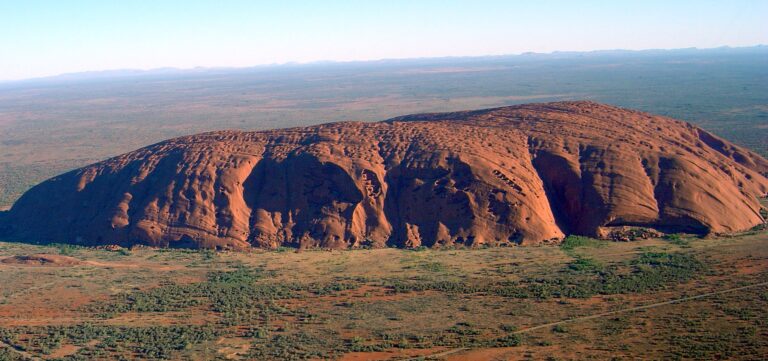Rising majestically from the ochre-red desert plains of Central Australia, Uluru, also known as Ayers Rock, is far more than just an impressive geological formation. It is a living cultural landscape, a deeply sacred site for the Anangu people, the traditional custodians of this land for tens of thousands of years. Its imposing presence and the spiritual significance woven into its very being make Uluru a powerful and unforgettable symbol of Australia’s ancient heart.
This colossal sandstone monolith stands at a breathtaking 348 meters high, with much of its bulk hidden beneath the earth’s surface. Its sheer size is awe-inspiring, stretching 3.6 kilometers long and 2 kilometers wide. What truly captivates, however, is its ever-changing appearance. As the sun traverses the sky, Uluru transforms through a spectacular spectrum of colors, from deep reds and oranges at dawn and dusk to softer hues during the day. This dramatic display has fascinated visitors for generations, but for the Anangu, these color shifts hold deep spiritual meaning, reflecting the stories and ancestral beings connected to the rock.
For the Anangu, Uluru is not simply a rock; it is a tangible manifestation of their Tjukurpa, or Dreamtime – the foundation of their culture, law, and spirituality. According to their traditions, Uluru was formed by ancestral beings during the creation period. The many features of the rock – its caves, fissures, and waterholes – are imbued with the stories and activities of these ancestral figures. Each mark and contour tells a tale, connecting the Anangu people to their past, their land, and their spiritual heritage.
Understanding Uluru through the lens of Anangu culture reveals a depth of meaning that transcends its geological grandeur. The rock is a vital part of a living cultural landscape that includes the surrounding environment, the plants, the animals, and the stories that bind them together. For the Anangu, walking around Uluru is a journey through their history, a connection to their ancestors, and a reaffirmation of their identity.
While the allure of climbing Uluru once drew many tourists, a profound shift has occurred in recent years, largely driven by the persistent advocacy of the Anangu people. Recognizing the deep spiritual significance of the rock and the pain caused by people ascending their sacred site, a climbing ban was finally implemented in October 2019. This landmark decision was a significant step towards reconciliation and a recognition of Indigenous cultural rights. Today, visitors are encouraged to experience Uluru through respectful engagement with the land and the Anangu culture.
There are numerous ways to appreciate the majesty and spiritual significance of Uluru without climbing. Walking around the base offers a unique perspective, allowing visitors to connect with the rock’s textures, explore its waterholes and rock art sites, and learn about the Anangu stories associated with each location. Guided tours led by Anangu people provide invaluable insights into their culture, their relationship with the land, and the Tjukurpa narratives connected to Uluru. Witnessing the breathtaking sunrise or sunset over Uluru is an unforgettable experience, painting the monolith in vibrant colors and evoking a sense of awe and wonder. The Uluru-Kata Tjuta Cultural Centre offers further opportunities to learn about Anangu culture, art, and the natural environment.
Uluru stands as a powerful reminder of the deep and enduring connection between Indigenous Australians and their land. It is a place of immense spiritual significance, a natural wonder, and a symbol of Australia’s ancient heritage. By respecting the wishes of the traditional owners and engaging with Uluru in a culturally sensitive way, visitors can experience the true essence of this remarkable landmark – a sacred heart beating in the center of Australia.



